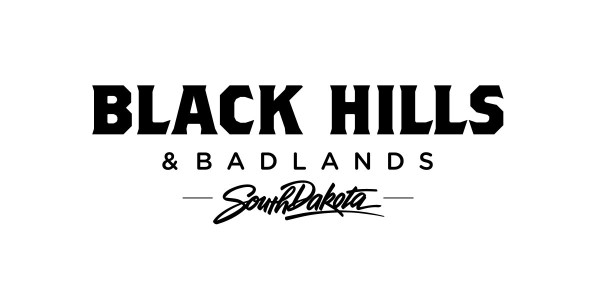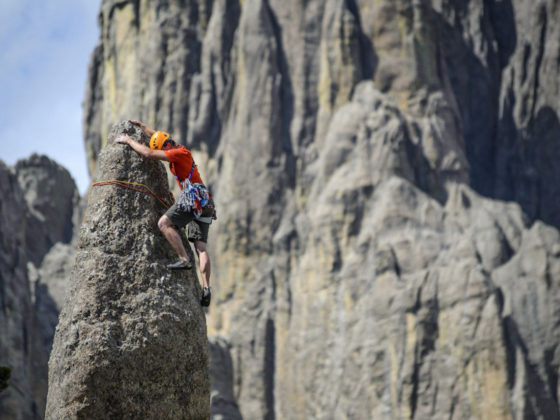ON THE WESTERN EDGE of South Dakota, the Earth awakens. In the middle of America’s heartland you’ll find the tallest peak east of the Rockies, where grasslands give way to forests of ponderosa pine for more than a million acres, and the famous spires of Custer State Park stand over herds of bison. These are the Black Hills.
And then, just to their east stretches one of the most inexplicable landscapes in all the country. The forests of the Black Hills quickly transform into a martian landscape left desolate by water and wind. South Dakota’s Badlands are a testament to the power of nature. Naturally, this region has a long list of secrets. What you see here is just the beginning.
1. Let’s set the record straight: The Black Hills aren’t black.

Photo: Travel South Dakota
The Black Hills are beautiful, the Black Hills are serene, but the Black Hills aren’t exactly black. The Lakota Sioux tribe called the small mountain range covered primarily by ponderosa pine trees Pahá Sápa, or “Hills That Are Black.” While looking at the Black Hills from afar may give you that impression, it’s the trees doing all the work — you’re seeing the shadows they cast on the stone.
In reality, the Black Hills are composed of hues of greens, reds, grays, browns, and golds, depending on the time of day. They’re that classic granite gray when the sun’s up and the trees aren’t casting shade, but come sunset you’ll notice them turning tinges of orange and even purple.
2. You’ve seen one particular Black Hill a million times.
Hands down one of the most recognizable landmarks in the United States is Mount Rushmore, located among the Black Hills near Keystone, South Dakota. The massive carved faces of American Presidents George Washington, Thomas Jefferson, Theodore Roosevelt, and Abraham Lincoln dominate the view from all around, and in total this national memorial is visited by more than two million people each year.
Stop into the visitor center and you’ll gain a new appreciation for this feat of engineering, totally changing how you look at the four granite faces. You’ll learn that they took 14 years to carve, accomplished by a team of 400+ workers who, once in their groove, could blast away at the rock with near perfect precision, nailing shapes on the first try. Whatever happens to us on this planet, Mount Rushmore will endure — scientists put its lifespan at about 7 million years.
3. There’s both a national park and a national monument underground.
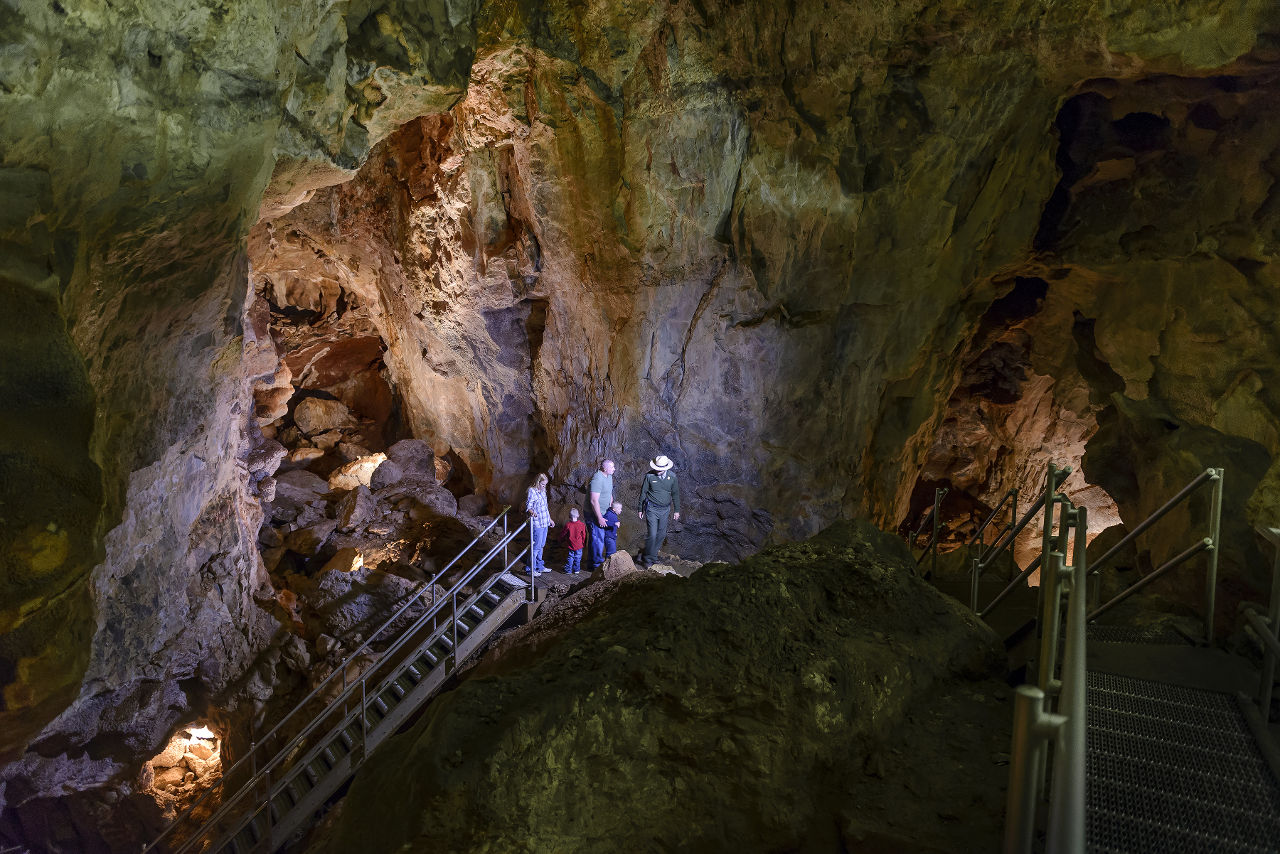
Photo courtesy of the South Dakota Department of Tourism
Drive, walk, or bike the entirety of the Black Hills & Badlands region and you’ll see a lot — but you won’t see it all. Wind Cave National Park and Jewel Cave National Monument are also in the neighborhood — or, well, under it. They’re two of the longest cave systems in the world, coming in at roughly 140 miles and 170 miles, respectively. Though Wind Cave is shorter, it was the seventh US national park and the first national “cave” park in the world. Not exactly how you picture the Midwest, right?
4. The Badlands have their own road trip.
If you want to experience the majesty of the Badlands but need to keep the motor running (or you forgot your hiking boots), drive I-90 going east and take exit 110. You’re welcome.
This is the Badlands Loop State Scenic Byway. South Dakota Highway 240 winds its way through the eastern portion of Badlands National Park, snaking and crawling between ancient rock formations, cliffs, and colorful spires. The road runs about 40 miles — it’s a two-laner — and it’ll take about two hours if you stop at the overlooks (you’ll want to stop at the overlooks). If nothing else, be sure to catch the Big Badlands Overlook, Pinnacles Overlook, and Yellow Mounds Overlook. There are 12 others and eight trailheads to pick from, in case you did end up bringing those hiking boots.
5. Mount Rushmore isn’t the only name carved in stone.
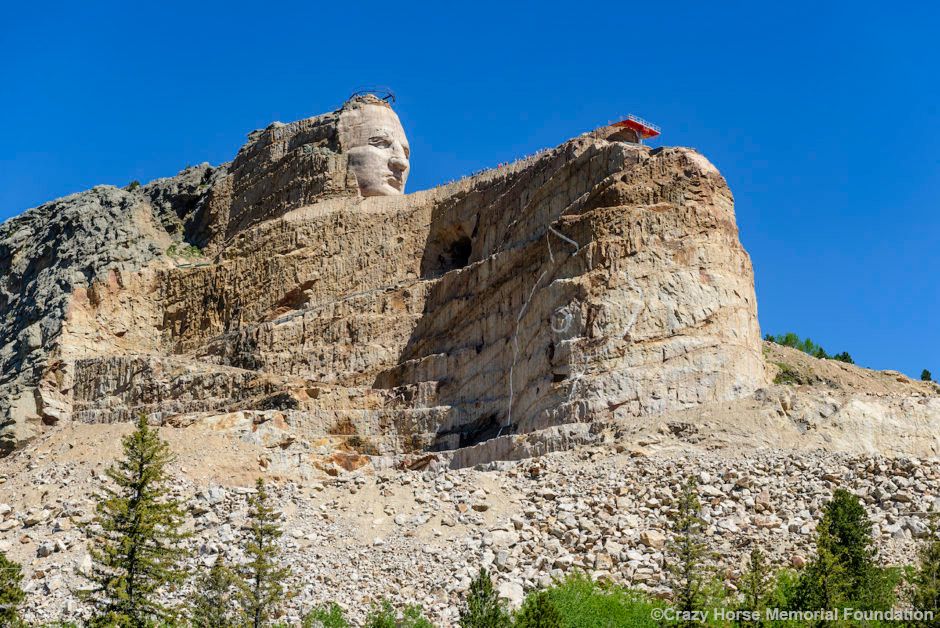
Photo courtesy of the South Dakota Department of Tourism
Located between Custer and Hill City and about 17 miles from Mount Rushmore, the Crazy Horse Memorial — another dynamite-blasted, intricately carved Black Hills behemoth — has been under construction since 1948. Korczak Ziolkowski, its creator, also worked on Rushmore…but only for 19 days. An argument led to his departure and, ultimately, his own monument: Crazy Horse.
Featuring the Oglala Lakota leader, the statue will be 563 feet tall, the tallest sculpture in the world once it’s completed. After 70 years work is still underway, but that doesn’t stop over a million people from visiting the ongoing project every year. One great way to see it: On the first full weekend in June, hikers are invited on the Volksmarch, a 6.2-mile trek that ends with a walk up the monument and down Crazy Horse’s in-progress outstretched arm. It’s a 32-year-old tradition, one so popular that, for the last five years, it’s been replicated in the fall. The dates of the two Volksmarches in 2017 are June 3-4 and October 1.
6. Sometimes mountains change names.
The massive Black Hills National Forest spans more than 1.25 million acres and contains the state’s tallest mountain: Black Elk Peak, coming in at 7,244 feet. Located just a few short miles from Mount Rushmore, this summit is the highest point east of the Rocky Mountains.
The name was changed in 2016 from Harney Peak. William S. Harney was a general in the Mexican-American and Indian Wars, and those etymological origins were abandoned in favor of honoring the original inhabitants of this region. The new name of Black Elk Peak recognizes the legendary Lakota Sioux medicine man as well as the state’s important Native American communities.
7. Mammoth fossils are still being excavated here.

Photo courtesy of the South Dakota Department of Tourism
Some 60 individual mammoth remains have been identified and preserved at the Mammoth Site in Hot Springs, South Dakota. A construction crew stumbled across the mass gravesite for Columbian Mammoths (and three woollies!) in 1974, and a museum now resides where excavations are ongoing. The site is home to the largest repository of Columbian mammoths on the continent, even more proof of South Dakota’s complex past.
About 26,000 years ago, this spot was a large sinkhole (technically a karst sinkhole), which led to the demise of the mammoths still trapped within it. Nowadays, you can take a 30-minute tour of the sinkhole and actually see an active archaeological project up close and in action. Admission is around $10 for adults and $7 for kids, and the site is open year-round.
8. Look no further for the ultimate roadside attraction.
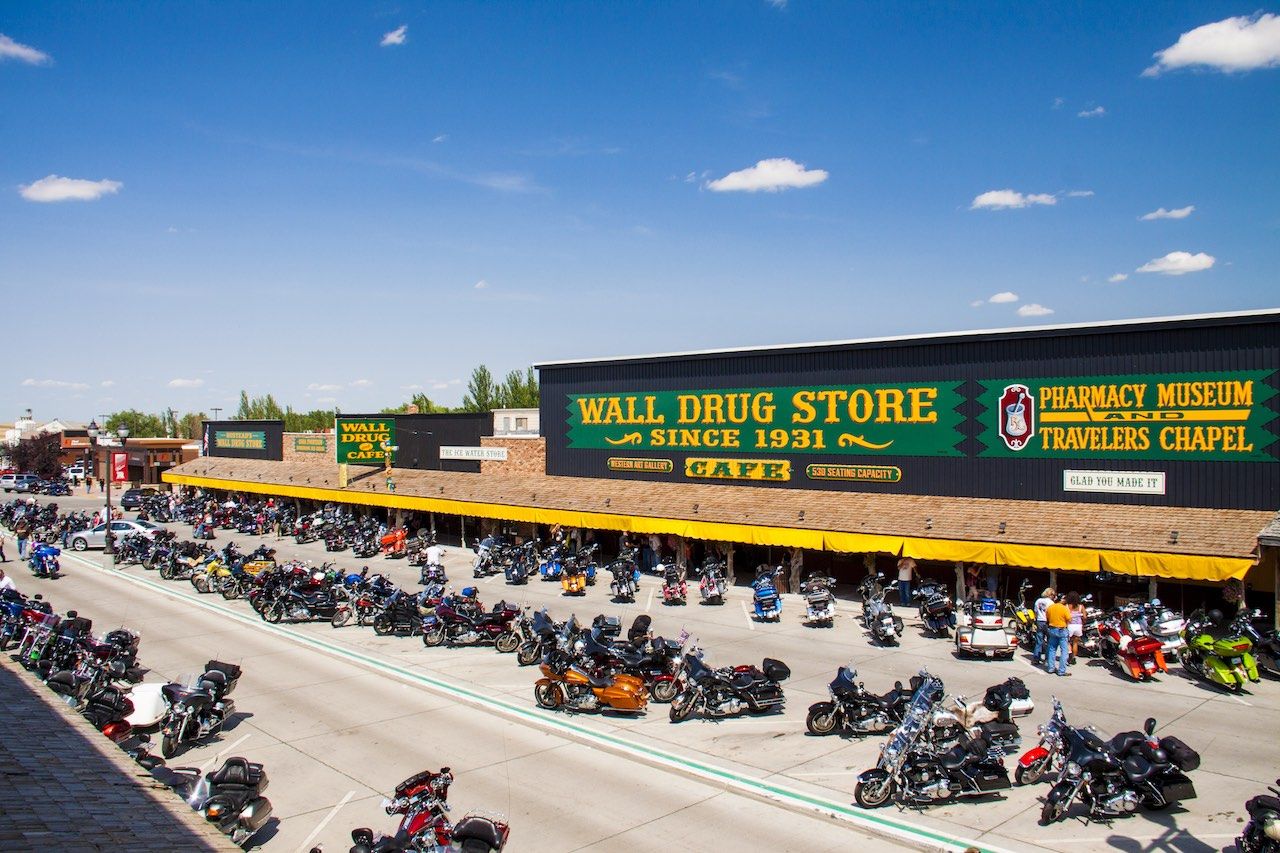
Photo: Wall Drug Store
It doesn’t matter if you’re in Toronto, South Dakota, or Toronto, Ontario — you’ve seen a Wall Drug bumper sticker and wondered just what you were looking at. The explanation is a little complicated, but Wall (just north of Badlands National Park) is home to one of the most bizarre — and well-loved — tourist traps in the nation. When’s the last time you went to pick up a prescription and had to avoid an animatronic Tyrannosaurus rex? Wall Drug is the king of kitsch and worth a stop, whether kitsch is your thing or not.
When you’re there, you still won’t really know what’s going on. That’s the idea. Just know that you should indulge in the free ice water and the donuts, ride a giant jackalope, contemplate millions of dollars’ worth of paintings, and just take it all in. Wall Drug was designed to offer respite on a long drive, and it’s succeeded. Massively.
9. This is literally the halfway point of your cross-country road trip.
They don’t call it the middle of the map for nothing. Belle Fourche, South Dakota, is federally recognized as the geographic center of the United States. While you can take a picture standing on top of the marker located adjacent to the Tri-State Museum, the actual center of the nation is found nearly 21 miles north of Belle Fourche. You’d have to do a bit of trespassing and fence-hopping to find the real deal, though, so let’s call the marker off 5th Ave close enough.
10. The Black Hills Gold Rush puts California’s to shame.
The largest and deepest mine in the Western Hemisphere, Homestake Mine netted some 41 million ounces of gold in its 126 years of operation. Since 2002 (when the mine closed), the site and its 370 miles of tunnels have played host to an extensive laboratory and research facilities. One-hour tours are available, and for $5 you can even drive a golf ball into the 1000-foot-deep open cut of the mine.
Nerd bonus: The solar neutrino problem was first discovered here. Nowadays, this portion of the mine is referred to as the Sanford Underground Research Facility, or SURF.
11. There’s a time to grab your motorcycle…

Photo: City of Sturgis, SD
If you’re on the road here during the first week of August, you may notice an influx of two-wheelers on the highway. They’re probably on their way to the internationally famous Sturgis Motorcycle Rally in Sturgis, South Dakota.
The rally isn’t just for bandana’d and tattooed cyclists to ride in the breeze — there are always huge musical headliners, attendees from every continent, and all the leather you can handle (for better or worse). And don’t forget the Beard & Mustache contest, the Tuesday Tattoo Contest, and the Street Food Throw Down. Yes, you’re allowed to gawk.
12. …and a time to race to the outhouse.

Photo courtesy of Black Hills & Badlands Tourism Association
Getting to the bathroom can sometimes feel like a race to the finish line, but residents of Nemo, South Dakota, really take it to the next level. So next level it’s hard to believe…
Each year, an annual outhouse race — yes, that’s a thing — called the Nemo 500 sees one rider on the pot while a team of four or five push to the end. An accompanying chili cook-off in the morning helps competitors get the fuel they need and keeps spectators busy between launches. It doesn’t really matter who wins (though imagine those bragging rights!), as all the proceeds go to providing medical assistance to children.
13. Our poker game is strong…
Deadwood, South Dakota — where Wild Bill Hickok used to spend his days — is more than an HBO series. The gold rush town may have a population of less than 1,500, but it’s sort of become South Dakota’s answer to Vegas. Well, maybe if you combined Vegas with Tombstone. You’re never far from a slot machine (gambling is allowed here for those 21+), festivals and concerts happen on the regular, and the town’s Old West history has buried a lot more than the occasional bank account.
The first order of the day is to stop by Saloon #10 — nowadays both a bar and a museum — to see Wild Bill Hickok’s “Dead Man’s Hand,” the poker game where he ultimately lost his life. There’s also dining upstairs at the Deadwood Social Club, live music, a martini bar, and South Dakota’s largest selection of whiskey at the American Whiskey Bar.
Before you head out, stop by Mount Moriah Cemetery — it’s the final resting place of Hickok, as well as famous frontierswoman Calamity Jane. As for whether or not the town is haunted, you’ll just have to find out for yourself.
14. …and our brewing game is, too.

Photo: Miner Brewing Company
The Black Hills region is becoming known for more than just pinnacles, kitschy drug stores, and Wild West history — it’s also something of a craft beer and winemaking hotspot. You’ll find multiple wineries on the Highway 385 wine trail between Hill City and Deadwood, while quality breweries are dotted across the region. Here are some standouts:
- Miner Brewing Company, Hill City – They’ve got a little bit of everything, but those who enjoy IBUs in the triple digits will love the Imperial IPA.
- Belle Joli Winery, Sturgis – With a focus on sparkling wines produced in the champagne tradition, Belle Joli aims to surprise.
- Mt. Rushmore Brewing Co., Custer – A brand-new addition to the brewpub scene, with a full-menu restaurant and 24 rotating regional taps.
- Naked Winery, Hill City – These guys do it all…beer and wine! Absolutely essential if you can’t make up your mind.
And that’s just the beginning. Surprised yet?
